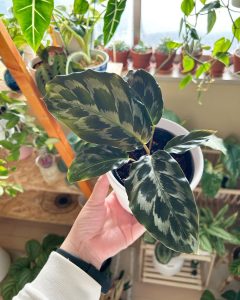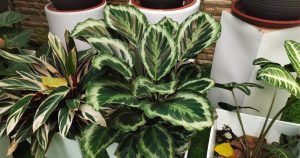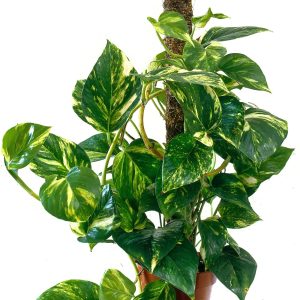Aglaonema Pictum Tricolor Care Tips & Tricks with Photos & Videos
Welcome to our comprehensive guide on caring for the Aglaonema pictum tricolor. This rare and highly sought-after plant in the Aglaonema genus is known for its stunning variegated leaves, featuring three shades of green in a camouflage-like pattern. In this article, we will provide you with all the essential care tips and tricks to ensure your Aglaonema pictum tricolor thrives in your home or office.
If you’re looking for guidance on how to care for aglaonema pictum tricolor, you’ve come to the right place. We will cover all aspects of aglaonema pictum tricolor care, including watering, light requirements, propagation, soil care, and more. Whether you’re a beginner or an experienced plant enthusiast, this care guide will help you keep your aglaonema pictum tricolor healthy and beautiful.
But first, let’s take a closer look at the aglaonema pictum tricolor plant itself.
In This Article
Botanical Name and Common Name
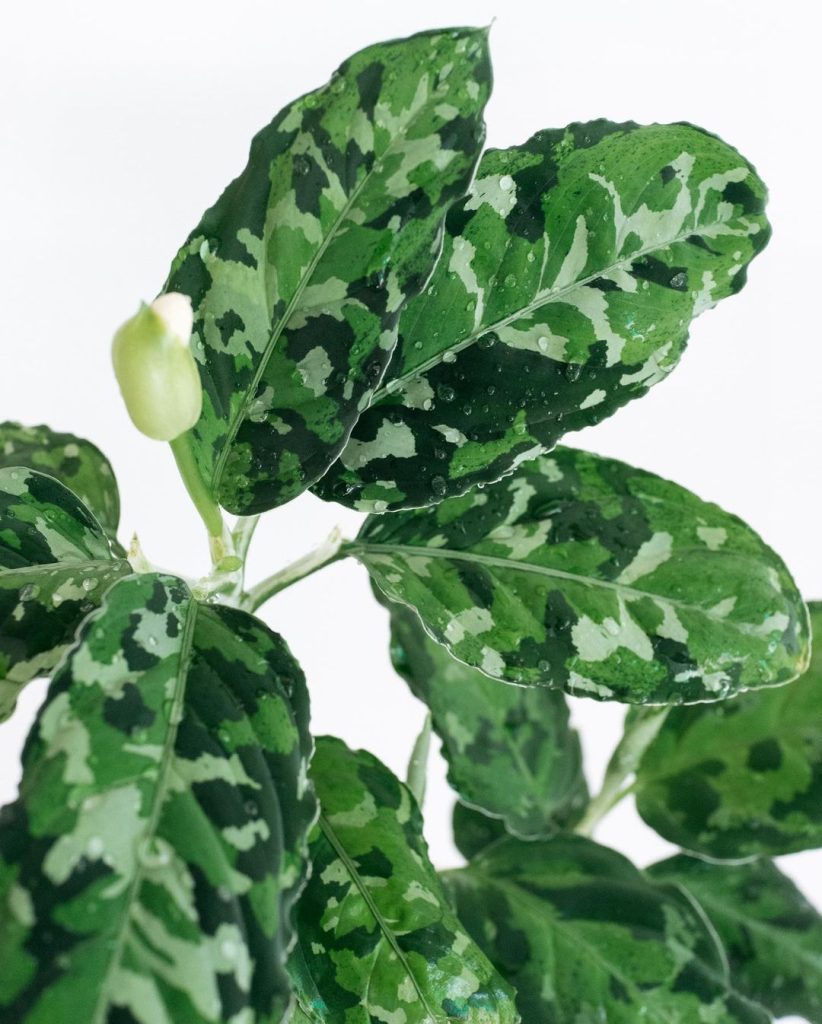
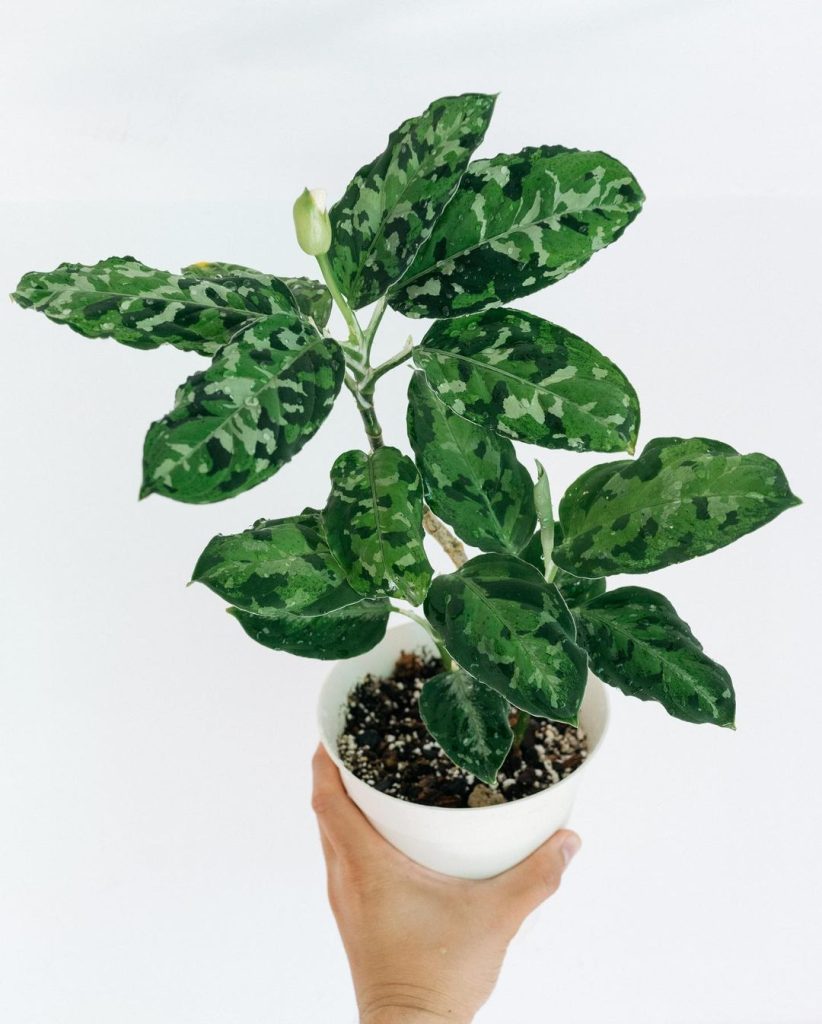
The Aglaonema pictum tricolor, also known as the camouflage plant or Chinese evergreen tricolor, is a small shrub belonging to the Araceae (Arum) family. This unique plant can grow up to 1-2 feet tall and is highly prized for its stunning variegated leaves, which display a camouflage-like pattern with three shades of green.
With its botanical name, Aglaonema pictum tricolor, highlighting its distinct characteristics and its common names, camouflage plant and Chinese evergreen tricolor, reflecting its unique appearance and cultural associations, this plant is a true beauty in the world of indoor gardening.
| Botanical Name | Aglaonema pictum tricolor |
|---|---|
| Common Name | Camouflage Plant, Chinese Evergreen Tricolor |
| Family | Araceae (Arum family) |
| Height | 1-2 feet |
Native Area and Hardiness Zones
The Aglaonema pictum tricolor, also known as the camouflage plant or Chinese evergreen tricolor, is native to subtropical regions in Asia. More specifically, it is found on the slopes of volcanoes in Sumatra and Nias Island. These lush and tropical environments provide the perfect conditions for the Aglaonema pictum tricolor to thrive.
When it comes to hardiness zones, this stunning plant is best suited for zones 10-12 in the United States. If you reside in these regions, you’re in luck – your Aglaonema pictum tricolor can flourish outdoors, bringing its unique beauty to your garden or patio.
This image showcases the vibrant and variegated leaves of the Aglaonema pictum tricolor, making it a captivating addition to any indoor or outdoor space.
Where to Buy Aglaonema Pictum Tricolor
You can buy Aglaonema pictum tricolor from local nurseries, online plant retailers like Etsy or Amazon, and specialty plant shops. Check social media plant communities or attend local plant swaps for potential sources.
Light Requirements
The Aglaonema pictum tricolor requires bright, indirect light for optimal growth and health. To provide the right amount of light, it is recommended to place the plant in an east-facing spot where it can receive some morning sun. This will provide it with the necessary energy to thrive.
However, it’s important to avoid placing the plant in direct sunlight, especially during the harsh afternoon hours. Direct sun exposure can be detrimental to the variegated leaves of the Aglaonema pictum tricolor, causing them to burn and lose their vibrant colors. Therefore, it’s best to shield the plant from direct sunlight and opt for bright indirect light for the rest of the day.
Optimizing Light Conditions
Here are some tips to optimize the lighting conditions for your Aglaonema pictum tricolor:
- Place the plant near a window with filtered or sheer curtains to diffuse the sunlight.
- If your only available windows face south or west, consider using a sheer curtain or placing the plant a few feet away from the window to prevent direct sunlight exposure.
- Observe your plant’s response to light and adjust its position accordingly. If the leaves start to appear faded or yellowed, it may indicate that it’s receiving too much light. Similarly, if the leaves are dark green and appear stretched out, it may indicate that it’s not receiving enough light.
By understanding and providing the proper light requirements for your Aglaonema pictum tricolor, you can ensure its development and showcase the full beauty of its variegated foliage.
Watering and Soil Requirements
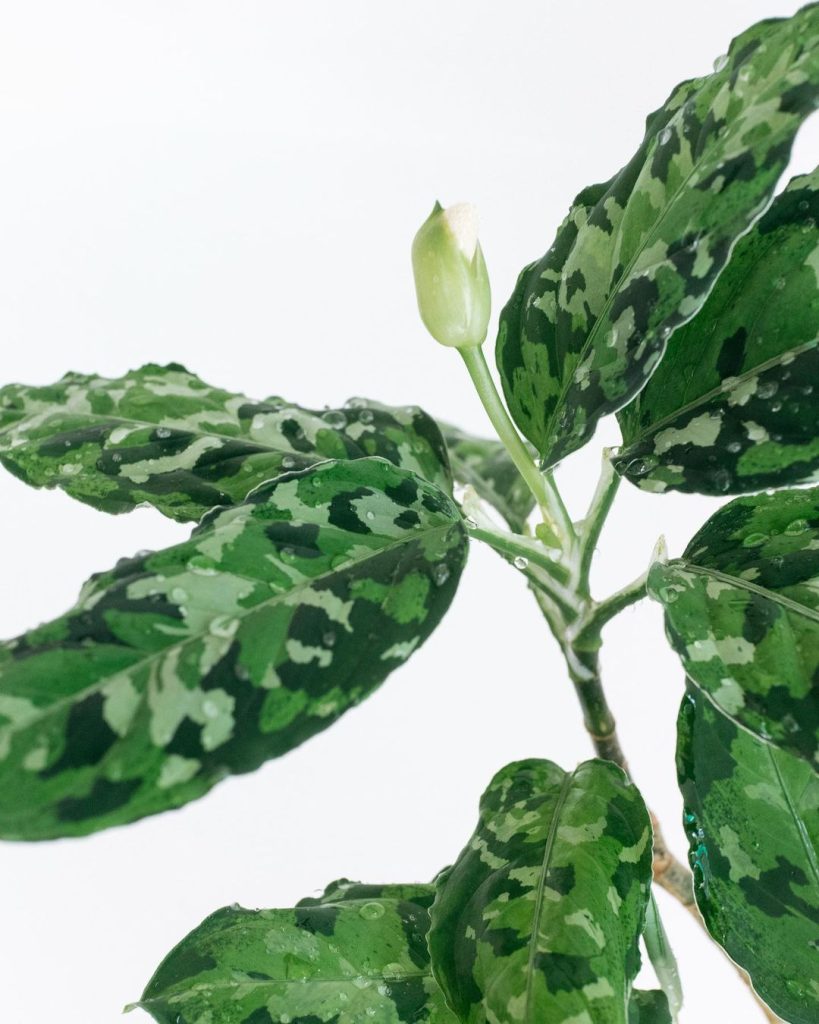
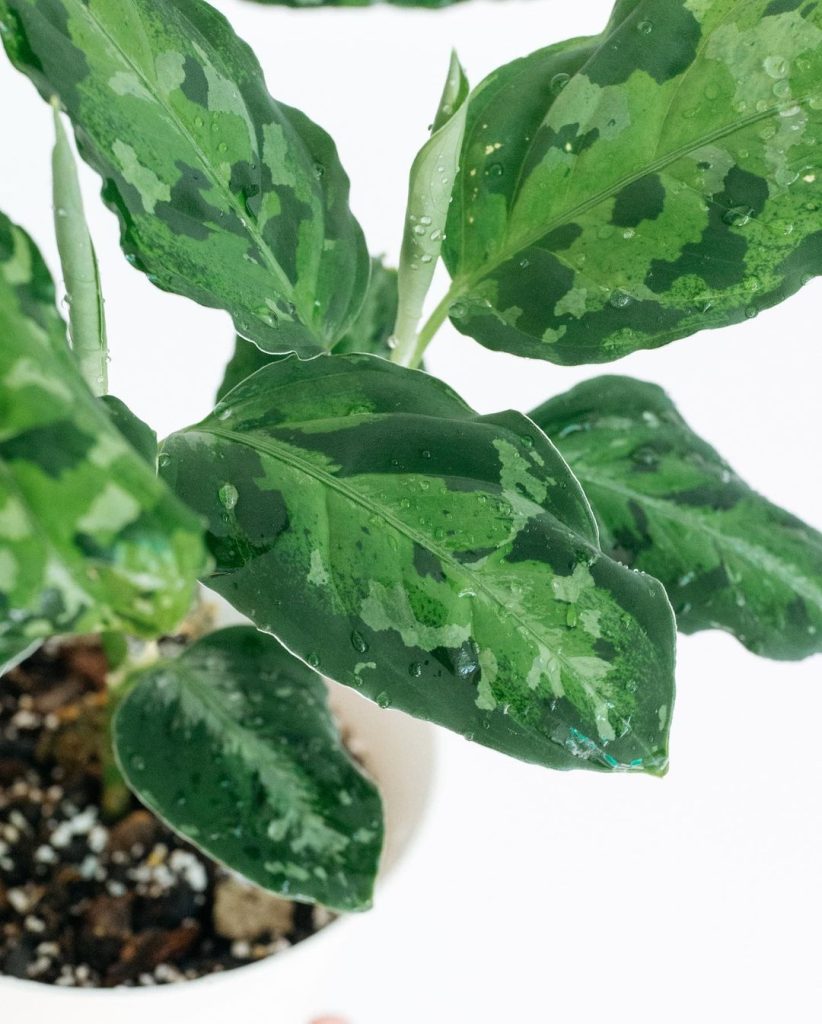
Proper watering and soil requirements are essential for the healthy growth of your Aglaonema pictum tricolor. This section will provide you with the necessary guidelines to keep your plant thriving.
Also Read:
Watering
To maintain optimal moisture levels, it is crucial to water your Aglaonema pictum tricolor appropriately. Overwatering can lead to root rot, while underwatering can cause the plant to dry out.
Here are some watering tips for your Aglaonema pictum tricolor:
- Check the moisture level of the soil by inserting your finger into the top inch. If the soil feels dry, it’s time to water your plant.
- Water your plant thoroughly until you see water draining out from the bottom of the pot. This ensures that the entire root system is adequately hydrated.
- Avoid letting the plant sit in excess water, as it can lead to root rot. Make sure the pot has proper drainage to allow excess water to escape.
- Establish a consistent watering schedule, aiming to water your Aglaonema pictum tricolor once the top inch of soil has dried out.
By following these watering guidelines, you can provide your plant with the right amount of moisture to thrive.
Soil Requirements
Choosing the right soil mix is crucial for the Aglaonema pictum tricolor’s overall health and growth. A well-draining soil mixture that retains some moisture is ideal for this plant.
Here is a recommended soil mix for your Aglaonema pictum tricolor:
- Indoor potting soil
- Perlite
- Orchid bark
Combining these components creates a well-draining soil mix that retains moisture without becoming overly saturated. This allows for sufficient root aeration and prevents waterlogged conditions.
Remember to repot your Aglaonema pictum tricolor every 2-3 years or when it outgrows its potting container. When repotting, choose a pot that is only 2-4 inches larger than the current one to prevent excessive moisture retention.
By providing the right watering and soil conditions, you can ensure the longevity and vitality of your Aglaonema pictum tricolor.
Temperature and Humidity Requirements
To ensure the optimal growth and health of your Aglaonema pictum tricolor, it is essential to provide the right temperature and humidity conditions. This section will guide you through the requirements for maintaining the ideal environment for your plant.
Temperature Requirements
The Aglaonema pictum tricolor thrives in warm temperatures and cannot tolerate colder conditions. It is crucial to keep the plant away from drafts or areas with temperatures below 60 degrees Fahrenheit (15 degrees Celsius). Placing the plant near windows or doors that may let in cold air should be avoided to prevent damage to the leaves and overall growth.
Humidity Requirements
Aglaonema pictum tricolor plants are accustomed to high humidity levels in their native tropical habitats. To replicate these conditions, aim for a humidity level above 65%. You can achieve this by placing the plant in a naturally humid room, such as a bathroom, or near a small humidifier. Another option is to keep the plant in a greenhouse cabinet, where humidity levels are easier to control.
Creating a humid microclimate around the plant can be beneficial. You can mist the leaves regularly to increase humidity or place a tray filled with water and pebbles near the plant. As the water evaporates, it will increase the moisture in the surrounding air.
| Temperature | Humidity |
|---|---|
| Avoid temperatures below 60°F (15°C) | Maintain humidity levels above 65% |
| Place away from drafts | Mist leaves or use a humidifier |
| Avoid exposure to cold air | Consider using a greenhouse cabinet |
Fertilizing
To keep your Aglaonema pictum tricolor healthy and thriving, regular fertilizing is essential. By providing the right nutrients, you can ensure vibrant foliage and robust growth. Follow these guidelines for fertilizing your Aglaonema pictum tricolor:
Frequency and Timing
- Fertilize your Aglaonema pictum tricolor once every two weeks during the spring and summer, which are the active growing seasons for the plant.
- During the fall and winter months, when the plant is dormant, it does not require additional fertilization.
Choice of Fertilizer
- Use a liquid fertilizer specifically designed for houseplants. Look for a balanced formula, such as a 10-10-10 or 20-20-20, to ensure a good mix of essential nutrients.
- Dilute the liquid fertilizer according to the manufacturer’s instructions. Over-fertilization can lead to nutrient burn and damage the roots, so it’s important to follow the recommended dosage.
Application
- Water your Aglaonema pictum tricolor thoroughly before applying the fertilizer. This helps prevent the roots from absorbing concentrated nutrients and getting burned.
- Pour the diluted fertilizer into the potting soil around the base of the plant. Avoid getting the fertilizer on the leaves, as it can cause leaf burn.
- After applying the fertilizer, water the plant again to ensure proper absorption and to avoid any potential buildup of salts in the soil.
By following these fertilizing guidelines, you can provide your Aglaonema pictum tricolor with the necessary nutrients for healthy growth. Remember to always read the instructions on the fertilizer packaging and adjust the frequency and dosage as needed based on the specific needs of your plant.
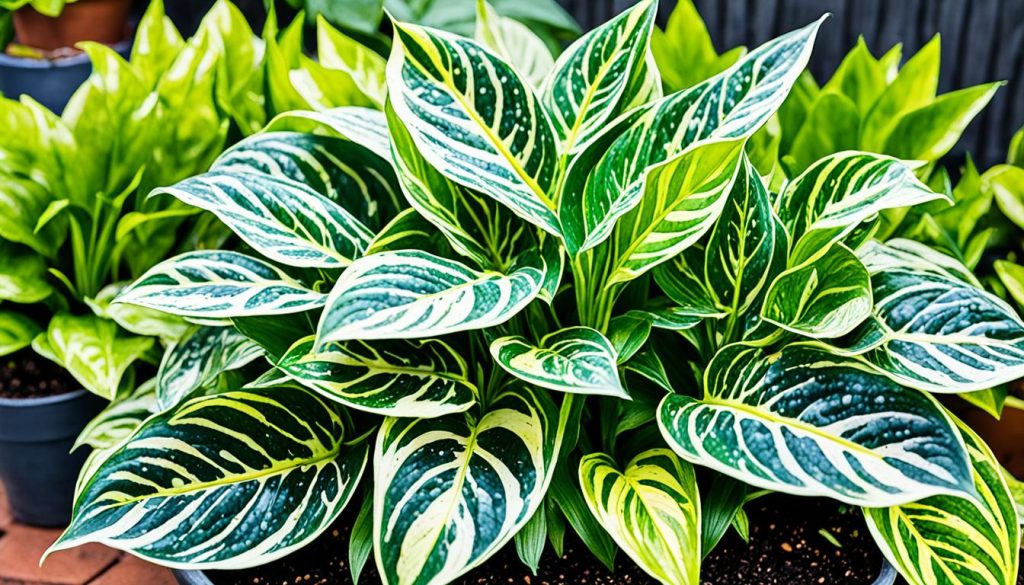
Propagation Methods
To propagate an Aglaonema pictum tricolor, you have two main options: division and stem cuttings. Both methods are fairly straightforward and can help you create new plants from your existing one.
Division
One way to propagate the Aglaonema pictum tricolor is through division. This method is best used when the plant has outgrown its original pot or when you notice multiple offshoots growing from the main plant.
To divide the plant:
- Remove the plant from its pot, being careful not to damage the roots.
- Gently separate the offshoots from the main plant. Each offshoot should have its own healthy root system.
- Pot each offshoot individually in a well-draining potting mix.
- Water the newly potted offshoots and place them in a suitable location with appropriate lighting conditions.
Stem Cuttings
Another effective propagation method for the Aglaonema pictum tricolor is through stem cuttings. This method is particularly useful when you want to create multiple new plants from a single specimen.
To propagate through stem cuttings:
- Choose a healthy stem with multiple nodes.
- Cut the stem just below a node, ensuring that the cutting is about 4-6 inches long.
- Remove the lower leaves, leaving only a few at the top.
- Place the cutting in a glass of water or a well-draining potting mix, covering the lower nodes.
- Keep the cutting in a warm and moist environment, providing indirect light.
- Roots should start developing within a few weeks. Once the roots are well-established, you can transfer the cutting to its own pot.
It’s important to note that regular pruning is not necessary for the Aglaonema pictum tricolor. However, propagating through division and stem cuttings allows you to grow new plants and expand your collection.
Repotting
Aglaonema pictum tricolor plants do not require frequent repotting. It is recommended to repot them every 2-3 years or when the plant has outgrown its current pot. Repotting allows the plant to have enough space for its roots to grow and prevents it from becoming root-bound.
When repotting your aglaonema pictum tricolor, choose a pot that is only 2-4 inches larger in diameter than its previous pot. Selecting a pot that is too large can lead to overwatering and increased risk of root rot.
Here are the steps to repot your aglaonema pictum tricolor:
- Prepare a new pot with adequate drainage holes at the bottom.
- Gently remove the plant from its current pot, being careful not to damage the roots.
- Inspect the roots and trim any damaged or dead roots with clean, sharp pruning shears.
- Place a layer of fresh, well-draining potting soil at the bottom of the new pot.
- Position the plant in the center of the pot and fill in the remaining space with more potting soil, gently pressing it down to secure the plant.
- Water the plant thoroughly, allowing any excess water to drain out of the pot.
After repotting, monitor the moisture levels closely and adjust your watering routine accordingly. It is normal for a newly repotted plant to go through a period of adjustment, so give it some time to settle into its new container.
Remember to consider the size of the plant and its growth rate when determining the frequency of repotting. If the plant is not showing signs of being root-bound and the current pot is still suitable, you can postpone the repotting process until it is necessary.
Benefits of Repotting
Repotting your aglaonema pictum tricolor has several benefits:
- Allows the plant’s roots to have enough space to grow and absorb nutrients.
- Refreshes the potting soil, providing a nutrient-rich environment for the plant.
- Prevents the plant from becoming root-bound, which can lead to stunted growth.
- Improves overall plant health and appearance.
By following proper repotting techniques, you can ensure the continued growth and well-being of your aglaonema pictum tricolor.
| Pot Size | Repotting Frequency |
|---|---|
| 4-6 inches | Every 2-3 years |
| 6-8 inches | Every 3-4 years |
| 8-10 inches | Every 4-5 years |
Common Pests and Diseases
While the Aglaonema pictum tricolor is generally resilient, it is not immune to pest and disease issues. Common pests that can affect this plant include aphids, mealybugs, spider mites, and scale insects. These pests can cause damage to the leaves and overall health of the plant.
To prevent pest infestations, it is important to regularly inspect your Aglaonema pictum tricolor for any signs of these pests. Look for small insects, webs, or sticky residue on the leaves. If you notice any pest activity, it is crucial to take immediate action to prevent further damage.
One effective way to combat these pests is to use neem oil, which is a natural insecticide. Dilute the neem oil according to the instructions and apply it to the affected areas of the plant. This will help to eliminate the pests and protect the health of your Aglaonema pictum tricolor.
Additionally, it is important to maintain proper drainage and avoid overwatering your plant. Overwatering can lead to root rot, which is a common problem for Aglaonema plants. Ensure that the soil is well-draining and only water the plant when the top inch of soil feels dry to the touch.
By regularly monitoring your Aglaonema pictum tricolor for pests, treating any infestations promptly, and providing optimal growing conditions, you can keep your plant healthy and thriving.
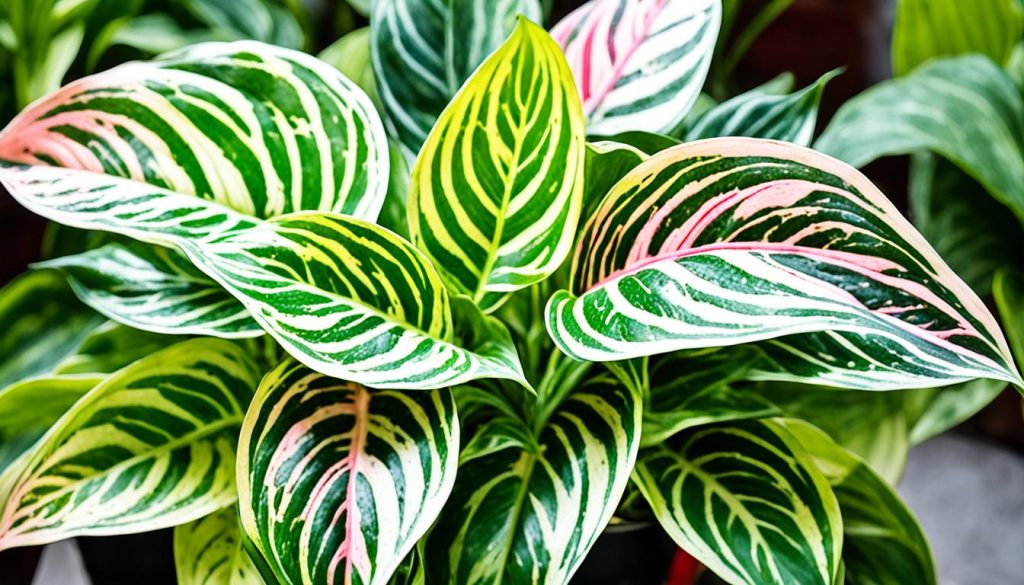
Common Problems and Troubleshooting
The Aglaonema pictum tricolor is a resilient plant, but it can still encounter some common problems. One of the most common issues is brown leaves, which can be caused by underwatering or a lack of humidity. To remedy this, make sure you are watering the plant adequately and consider using a humidifier or placing a tray of water near the plant to increase humidity levels.
Yellow leaves are another problem you may encounter with your Aglaonema pictum tricolor. This is often a sign of overwatering or underwatering. Ensure that you are watering the plant appropriately, allowing the top inch of soil to dry out before watering again. It’s important to strike a balance and not let the plant sit in soggy soil.
Drooping leaves can be a result of too much sun or insufficient watering. If your Aglaonema pictum tricolor is situated in a spot with intense sunlight, consider moving it to a location that offers bright, indirect light. Additionally, check the moisture level of the soil and adjust your watering routine as needed.
Remember to regularly monitor your plant for any signs of pests or diseases. Inspect the leaves and stems for any unusual spots, webs, or tiny insects. If you notice any issues, take prompt action by treating the plant with appropriate insecticides or remedies for houseplants.
FAQ
How do I care for Aglaonema pictum tricolor?
Aglaonema pictum tricolor requires bright, indirect light, moist but well-draining acidic soil, and regular watering. It thrives in warm, humid conditions and should be fertilized every two weeks during the growing season. The plant can be propagated through division or stem cuttings, and it should be repotted every 2-3 years. Common problems include brown leaves, yellow leaves, and drooping leaves, which can be resolved by adjusting watering and humidity levels.
What is the botanical name and common name of Aglaonema pictum tricolor?
The botanical name of Aglaonema pictum tricolor is Aglaonema pictum tricolor. It is commonly known as the camouflage plant or Chinese evergreen tricolor.
Where is Aglaonema pictum tricolor native to and which hardiness zones does it thrive in?
Aglaonema pictum tricolor is native to subtropical regions in Asia, specifically the slopes of volcanoes in Sumatra and Nias Island. It thrives in hardiness zones 10-12 in the United States.
What are the light requirements for Aglaonema pictum tricolor?
Aglaonema pictum tricolor requires bright, indirect light. It should be placed in an east-facing spot where it can receive some morning sun and bright indirect light for the rest of the day. Direct sunlight, especially harsh afternoon sun, should be avoided as it can burn the variegated leaves.
How often should I water Aglaonema pictum tricolor and what type of soil does it prefer?
Aglaonema pictum tricolor appreciates consistently moist soil, but it is sensitive to root rot. Water the plant once the top inch of soil has dried out, ensuring that any excess water drains from the pot. Use well-draining soil that retains some water while draining well, such as a mix of indoor potting soil, perlite, and orchid bark. Avoid letting the plant dry out completely, but also avoid overwatering.
What are the temperature and humidity requirements for Aglaonema pictum tricolor?
Aglaonema pictum tricolor thrives in warm, humid conditions. It cannot tolerate temperatures below 60 degrees Fahrenheit and enjoys humidity levels above 65%. It is best to place the plant near a small humidifier or in a naturally humid room, such as a bathroom. Alternatively, it can be kept in a greenhouse cabinet.
How often should I fertilize Aglaonema pictum tricolor?
Fertilize Aglaonema pictum tricolor once every two weeks during the spring and summer using a diluted liquid fertilizer designed for houseplants. Stop fertilizing in the fall and winter when the plant is no longer actively growing.
How can I propagate Aglaonema pictum tricolor?
Aglaonema pictum tricolor can be easily propagated through division and stem cuttings. Offshoots can be separated from the main plant and potted individually, while stem cuttings with multiple nodes can be rooted in water or a well-draining potting mix. Regular pruning is not necessary for this plant.
How often should I repot Aglaonema pictum tricolor?
Aglaonema pictum tricolor does not need to be repotted frequently. Every 2-3 years, or when the plant has outgrown its potting container, it can be repotted. Choose a pot that is only 2-4 inches larger than its old pot to prevent accidental overwatering.
What are the common pests and diseases that affect Aglaonema pictum tricolor?
Aglaonema pictum tricolor is not particularly prone to pests or diseases but can be affected by aphids, mealybugs, spider mites, and scale insects. Regularly check for signs of infestation and treat accordingly with neem oil or insecticides designed for houseplants. Overwatering or soggy conditions can lead to root rot, so it is important to ensure proper drainage.
What are the common problems with Aglaonema pictum tricolor and how can I troubleshoot them?
Common problems with Aglaonema pictum tricolor include brown leaves (due to underwatering or lack of humidity), yellow leaves (a sign of overwatering or underwatering), and drooping leaves (caused by too much sun or insufficient watering). Adjust watering and humidity levels accordingly to resolve these issues. Regularly monitor the plant for any signs of pests or diseases and take prompt action if necessary.

